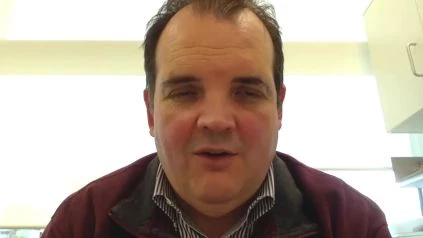Professor Ray McDermott of St. Vincent University Hospital and Tallaght Hospital, Ireland discusses ESMO – Survival benefits of larotrectinib in an integrated dataset of patients with TRK fusion cancer.
BACKGROUND
Fusions of the neurotrophic tyrosine receptor kinase (NTRK) gene encode chimeric fusion.
In a wide range of adult and pediatric tumors, tropomyosin receptor kinase (TRK) proteins, which are constitutively active and act as oncogenic motors.
In different paediatric and adult tumour types, NTRK gene fusions have been reported, with an average incidence of 1 percent in all solid tumour types. They occur more commonly in such rare tumors, such as salivary gland secretory carcinoma and infantile fibrosarcoma, with a prevalence of > 90%.1,2
In a variety of tumour forms, the discovery of NTRK gene fusions as oncogenic drivers has given actionable targets that have advanced therapeutic options.
Larotrectinib is a first-in-class, highly selective central nervous system ( CNS) active TRK inhibitor approved as a tumor-agnostic treatment for adult and pediatric patients with TRK fusion cancer in the EU and 40 countries, including the US.
In three clinical trials, a pooled study of 159 adult and pediatric patients with TRK fusion cancer found that larotrectinib found an investigator-assessed objective response rate (ORR) of 79 percent, 28.3 months of median progression-free survival (PFS) (95 percent confidence interval [CI] 22.1-not estimated [NE]) and 44.4 months of median overall survival ( OS) (95 percent 36.5-NE)
In an integrated dataset of 175 patients with TRK fusion cancer treated with larotrectinib, we record revised survival results with longer follow-up.
Data from three clinical trials are pooled for this study (NCT02122913, NCT02576431, and NCT02637687) of non-primary CNS TRK fusion cancer patients with detectable larotrectinib-treated disease.
Patients with locally advanced or metastatic disease who had progressed or were not receptive to available therapies or for whom no standard treatment was available included eligibility requirements.
Larotrectinib was given in adult patients at a dose of 100 mg twice daily and in most pediatric patients at a dose of 100 mg / m2 twice daily (maximum dose of 100 mg twice daily) before disease progression, withdrawal, or unacceptable toxicity. If the patient appeared to benefit, care beyond development was allowed.
As assessed by investigators using Response, the primary endpoint was ORR.
Strong Tumors Assessment Criteria v1.1 criteria.
PFS, OS, length of response (DoR), and protection were secondary endpoints.
The safety population included all patients who obtained at least one dose of larotrectinib, regardless of TRK fusion status (n=279), participating in one of the three clinical trials.
The data cut-off was 15 July 2019 for the extended integrated dataset study.
OUTCOMES
55 patients from the primary dataset and 120 patients in the supplementary data set were included in the enlarged integrated dataset.
From patients
The median age was 43 years ( range 0.1-84.0), with 59 paediatric patients (Table 1) (34 percent).
Soft tissue sarcoma (23 percent), infantile fibrosarcoma (19 percent), thyroid (16 percent), salivary gland (13 percent) and lung (8 percent) were among the most common tumour types.
In 55% of patients, NTRK3 gene fusions were registered, followed by 41% of NTRK1 gene fusions and 3% of NTRK2 gene fusions. A total of 33 different fusion partners have been reported, of which ETV6-NTRK3 (49%), TPM3-NTRK1 (18%) and LMNA-NTRK1 (9%) were the most common.
Effectiveness
Larotrectinib, irrespective of tumour form, was efficient.
The ORR was 78% (95 % CI 71–84): 19% full response, 59% partial response, 13% stable disease, and 7% progressive disease.
The ORR for adults ( aged 18 years) was 71% (95 % CI 62-79): 10% total.
Answer, partial answer 60 percent, stable illness 16 percent, and progressive illness 9 percent.
The ORR for paediatric patients was 92% (95 % CI 81-97): 36% total.
Answer, partial answer 56 percent, stable disease 7 percent, and progressive disease 2 percent.
At a median follow-up of 13.5 months, the median DoR was not reached and the median DoR was not reached.
The 12-month DoR rate was 81% (95 % CI 73-89), and 66% (95 % CI 53-78) was the 24-month DoR rate.
• At a median follow-up of 13.8 months, the median PFS was 36.8 months (95% 25.7-NE). The 12-month PFS average was 69 percent (95 percent CI 61–76) and 61 percent (95 percent CI 51–70) was the 24-month average.
With a median follow-up of 15.3 months, Median OS was not achieved. 90 percent was the 12-month OS rate (95 percent CI 85-95) and 83 percent was the 24-month OS rate (95 percent CI 75-90.
The median response time was 1.8 months (range 0.9-6.6) and the period of treatment varied from 0.1 to 51.6 + months.
The investigator-assessed ORR was 71 percent (95 percent CI 42–92) in 14 evaluable patients with brain metastases, with 10 patients achieving a partial response; 2 had stable disease and 2 had progressive disease.
The median DoR was 14.8 months, with a median follow-up of 9.5 months.
(95 percent CI 3.7–NE) and 61 percent (95 percent CI 26–96) was the 12-month DoR pace.
• 100 patients (57 percent) were still on medication at the data cut-off date and 32 patients (18 percent) continued post-progression medication.
CONCLUSIONSÂ
In this expanded study, the response to larotrectinib care in this adult and paediatric TRK fusion cancer population was rapid and durable with a median PFS of > 3 years.
Larotrectinib has continued to show a favorable long-term safety profile and has been well-tolerated due to AEs with very few discontinuations.
These data confirm and reinforce TRK fusion proteins as therapeutic targets.
Help for routine screening and testing of NTRK gene fusions in patients.

